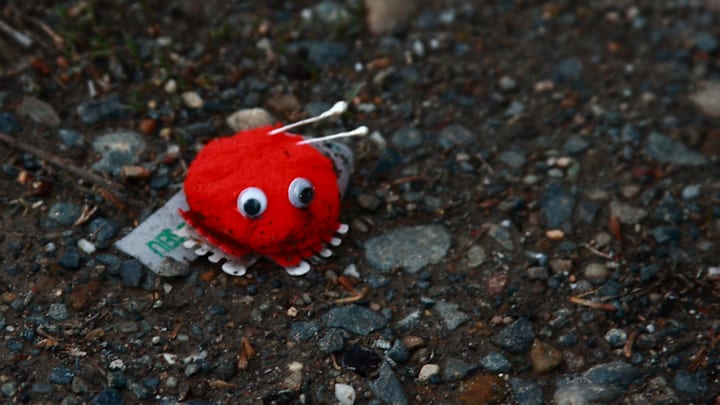You might not remember the name Weepul, but if you were a kid in the ’70s, ’80s, or ‘90s, you’ll remember what they look like. Essentially a ping-pong-sized, puffy, synthetic ball with googly eyes, antennae, and a set of flat, cartoonish sticker feet, Weepuls seemed to occupy every desk in every office in the late 20th century. But how did they go from cheap toy to ubiquitous marketing tool—and why have they disappeared everywhere except the Netherlands?
Arts and Crafts
Weepuls were invented by Tom Blundell, a recent U.S. Army veteran who was working for his parents’ plush toy company in 1971. While his parents were off on a vacation, Blundell started fooling around with various toy parts laying around the BIPO company’s Oklahoma City office. He glued some googly eyes onto one of the pompoms normally used for doll noses, he added feet to keep it from toppling over, and then he left it on his desk and went about his work.
When his parents came back, they were entranced. Blundell’s father thought the little knick-knack could be BIPO’s next big seller, seeing the promise in something that could be made incredibly cheaply, in massive quantities, and would cost consumers relatively little. Blundell’s mom had the idea to add antennae. Pulling inspiration from an old product that didn’t take off, they decided to call them “Weepuls,” or a mashup of the words wee and people. The family couldn’t have predicted just how big of a V-shaped footprint their idea would leave.

A Wee Phenomenon
Weepuls were soon on the market, rolling out in the toy sections of stores like Kmart. Within a few years, Tom Blundell came up with the idea of adding a fabric banner to the Weepuls’ feet that would display universal greetings like “Happy Birthday” or “Have a great day!” After purchasing the company from his parents in 1976, Blundell started making inroads in the promotional world, offering customers a customizable ribbon that they could emblazon with, for example, a realtor’s phone number or a thank you message from a local bank.
Most of the Weepuls available on the secondary market today are from this period, accumulated through restaurant or business promotions, trade shows, or even Sunday School giveaways. They were also a hot prize item for school magazine fundraisers, with different levels of sales earning kids increasingly elaborate Weepuls—or even bigger Weepuls, like the “life-sized” stuffed ones that were often awarded to the school’s biggest sellers. They were popular enough to bleed into other toy fads, with their fluffy silhouettes appearing on pogs.
If Weepuls seemed like they were omnipresent for decades, that’s because they were. Blundell estimates that by the time he sold BIPO—then renamed Weepuline, LLC—in 2012, the company had manufactured over 400 million Weepuls. They may not survive in the numbers that vintage Barbies or Troll dolls do today, but that’s really due to their durability—or lack thereof. Weepuls were by nature a little ephemeral. If you found one cleaning out a junk drawer, you’d throw it away; another seemed bound to come along one way or another. But then, in the 2000s, their dominance finally started to diminish.
Going Dutch
That is, unless you grew up in the Netherlands. For Dutch people in the ’80s, Weepuls—or as they called them, “Wuppies”—were not just a toy but a cultural phenomenon. A Dutch children’s singer named Vader (Father) Abraham released a whole album of songs about Wuppies in 1981, with one of the tracks, “Wij Zijn de Wuppies,” or “We Are The Wuppies,” hitting No. 14 on the pop music charts in the Netherlands.
Wuppies had such a hold on the country that in 2006, 25 years after their introduction, a Dutch supermarket chain called Albert Heijn used Wuppies in a promotional campaign for the FIFA World Cup. A play on Dutch football chant “Hup Holland Hup,” the “Wup Holland Wup” campaign rewarded loyal customers with orange, red, white, and blue Wuppie stamps. For three stamps and an additional €2.49, you could snag a “Mega Wup,” which Dutch drivers displayed on the dashboards of their cars until a rash of Wuppie thefts made the practice untenable. Even now, Wuppies still hold some cultural cache in the Netherlands, inspiring the logo for the popular Blijdorp Music Festival.
These days, you can still pick up official Weepuls from Weepuline via Weepuls.com. The company sells dozens upon dozens of different puff balls sporting everything from yarmulkes to top hats, and holding everything from beer bottles to bibles [PDF]. You can get custom Weepuls made, too, once you figure out what you want your ribbon to say.
Read More About Toy Fads:
